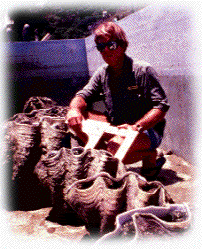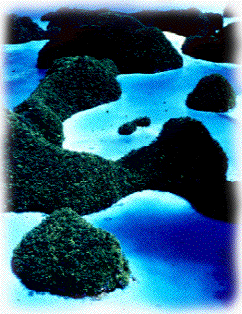

Gerald A. Heslinga, Founder of Indo-Pacific Sea Farms
Gerald Heslinga is a marine biologist who conducts applied research on the reproduction and developmental biology of tropical marine organisms. The emphasis of his work during the past 31 years has been on captive breeding of marine invertebrates, primarily echinoderms (starfish and sea urchins), molluscs (clams, snails and oysters) and cnidarians (corals, jellyfish and sea anemones). Gerald is best known for his pioneering research on the reproductive biology and mass culture of giant tridacnid clams in Palau, as principal investigator at the MMDC Giant Clam Hatchery during the 15-year period from 1981 through 1995. Innovative techniques and experimental results developed by Gerald and his research team at Palau have been widely disseminated among tropical Pacific nations and have positively affected Pacific coral reef conservation efforts, sustainable seafood production and the culture of reef organisms for ornamental and educational markets.
Gerald's work as founder and owner of Indo-Pacific Sea Farms in Hawaii is focused on the breeding and marketing of photo-symbiotic reef organisms such as tridacnid clams, alcyonacean and scleractinian corals. Recent applied research involves the culture of micro-invertebrates, ooze-dwelling detritivores, beneficial bacteria, planktonic feeds and various ornamental marine algal forms. Now in its twelfth year of operation on Hawaii's Kona coast, Indo-Pacific Sea Farms is recognized as an international leader in the development of environmentally sound approaches to the production and husbandry of beneficial marine organisms.
Gerald has been active in regional Pacific organizations such as the University of Hawaii's Pacific Aquaculture Association and the Oceanic Institute's Center for Tropical and Subtropical Aquaculture. He and his wife Kyoko have two daughters, Olivia and Lisa. In his spare time Gerald is a coach with Kailua-Kona's youth soccer programs.
Gerald is a 1976 Honors graduate of Harvard
College and was a Graduate Fellow from 1976 to 1981 at the Resource
Systems Institute of the University of Hawaii's East West Center.
 He has conducted research at Harvard's Museum of
Comparative Zoology (MCZ), the Environmental Systems Laboratory (ESL)
at Woods Hole Oceanographic Institute (WHOI), the University of
Hawaii Department of Zoology, the University of Guam Marine Laboratory,
the Micronesian Mariculture Demonstration Center (MMDC) in the Republic
of Palau and the Natural Energy Laboratory of Hawaii. He has lectured
at Harvard, the Woods Hole Oceanographic Institute, the University of
Hawaii, the University of the Philippines, James Cook University
of Australia, the Scripps Institute of Oceanography and the Marine
Biotechnology Institute of Japan, as well as at numerous national and
international marine science conferences. He has conducted international
professional consultancies in Japan, Australia, the Philippines, Papua New
Guinea, Fiji, the Solomon Islands, the Marshall Islands, the Federated States
of Micronesia (Yap, Chuuk, Pohnpei and Kosrae), as well as at Guam, Saipan
and Palau.
He has conducted research at Harvard's Museum of
Comparative Zoology (MCZ), the Environmental Systems Laboratory (ESL)
at Woods Hole Oceanographic Institute (WHOI), the University of
Hawaii Department of Zoology, the University of Guam Marine Laboratory,
the Micronesian Mariculture Demonstration Center (MMDC) in the Republic
of Palau and the Natural Energy Laboratory of Hawaii. He has lectured
at Harvard, the Woods Hole Oceanographic Institute, the University of
Hawaii, the University of the Philippines, James Cook University
of Australia, the Scripps Institute of Oceanography and the Marine
Biotechnology Institute of Japan, as well as at numerous national and
international marine science conferences. He has conducted international
professional consultancies in Japan, Australia, the Philippines, Papua New
Guinea, Fiji, the Solomon Islands, the Marshall Islands, the Federated States
of Micronesia (Yap, Chuuk, Pohnpei and Kosrae), as well as at Guam, Saipan
and Palau.
Gerald's work has been funded by Harvard College, the National Geographic Society, the East West Center, the Hawaiian Malacological Society, the U.S. National Oceanic and Atmospheric Administration (NOAA), the University of Hawaii Sea Grant Program, the U.S. Departments of Commerce, Agriculture and Interior, the United Nations Food and Agriculture Organization (UNFAO), the International Centre for Ocean Development (ICOD), the Marine Biotechnology Institute of Japan, Rolex of Geneva, the Australian Centre for International Agricultural Research (ACIAR), the United Nations South Pacific Aquaculture Development Program, the Marine Aquarium Society of North America (MASNA), the International Foundation of Canada and various other public and private sources. The support of these organizations is gratefully acknowledged.